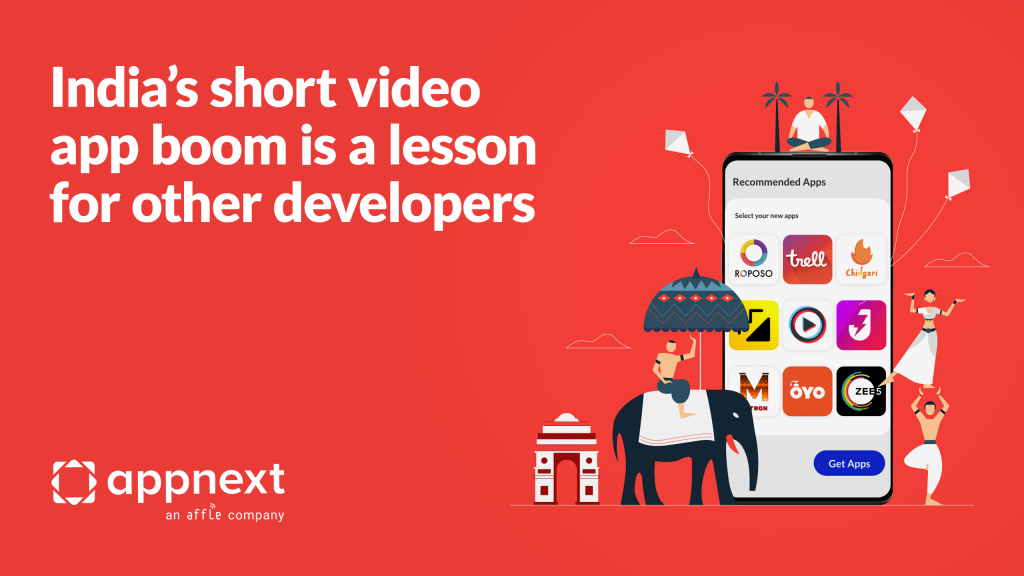India’s app economy is thriving right now. Not only does the country have the fourth largest app economy in the world, behind China, the US and Brazil, but it has overtaken Indonesia to become the fastest-growing apps market globally. In the midst of this boom, India’s homegrown app economy is flourishing. Last year, a total of 38.5% of all app installs came from domestic developers which represents more than 2.8 billion downloads.
As India’s domestic apps market has gone from strength to strength, one vertical has experienced meteoric growth: short video apps. Following the Indian government’s decision to ban Chinese-owned TikTok in June 2020, locally developed alternative apps have been jostling for their share of users after space opened up in this crowded market.
The void left behind by ByteDance’s TikTok has been mostly filled by three of India’s biggest players for short video apps: Josh, MX TakaTak, and Moj. Close competitors include the likes of Roposo, Mitron, Trell, and Chingari. In total, Indian apps have now captured 67% of TikTok’s subscribers and added a further 30-35% of new users over the past year. India-based consulting firm RedSeer has predicted a surge in short-form video engagement and has estimated the time spent on these apps will quadruple to 450 billion minutes a month in the next five years.
The world’s biggest developers are making huge investments in India’s homegrown apps on the back of the predictions that this market will swell. Unicorn startup ShareChat launched Moj just days after TikTok was banned. During its debut month last July, Moj broke records when it was downloaded 50,000 times in just two days. In February, content aggregator platform DailyHunt’s parent company VerSe Innovation announced it had secured $100 million to invest in Josh. Despite the ‘snackable’ short video app launching just six months ago, it has already climbed to the top spot among free social apps in the Google Play Store. Two months ago, MX Player’s app MX TakaTak became the most installed app in India with 36.5 million downloads. Moj followed closely behind with 23.5 million downloads.
For developers, there may be a lesson in the success of these apps. Indian users have gravitated to local app offerings for a number of reasons. One obvious reason is the type of localized content these apps are providing. In a country of 1.4 billion people who speak over 120 languages, many Indian smartphone users are seeking apps that can provide a more personalized experience. Josh is available in 12 Indian languages and is set to ramp up its local language content in an appeal to its domestic market. MX TakaTak has local languages and dialects such as Gujarati, Marathi, and Punjabi, while Moj can be used in Urdu, Assamese, Bengali, Odia, and Tamil. Overall, it is clear there is a demand from Indian users for localized content. Such users want videos in their own language from recognizable content creators. A key reason Josh has been successful is the level of personalization it extends. Josh is able to decode users’ preferences based on language and genres of interest and customize their feeds accordingly. Moj, which has gained popularity owing to its filters and AI editing tool, is similarly focused on improving personalization and is enhancing its users’ customized video feeds.
It is clear that bitesize video apps are now focusing on their user retention campaigns and ensuring they can keep the users they attracted since TikTok’s exit. The biggest platforms have been carving out a niche in the market and focusing on the innovative ways they can set themselves apart from their competitors. In the two months following its launch, Josh had already struck exclusive deals with hundreds of influencers and acquired over five million user-generated content creators. These creators now upload more than a billion videos per day.
Platforms Moj and Chingari have also formed partnerships with some of India’s biggest names. Last October, Chingari gained a million users in a matter of days after an agreement with Indian actress Madhuri Dixit Nene for her to host dance lesson videos. Moj came to a similar arrangement with singer-songwriter and social media star Ritviz to release exclusive short tracks to be used by the platform’s content creators. All of the platforms have pursued a similar strategy of forming exclusive relationships with high-profile content creators. Chingari is incorporating a feature that allows influencers to promote products from brands that are sponsored by the platform.
The biggest short video apps in India are not platforms that simply modelled themselves in TikTok’s image. Rather, they have focused on ways they can be unique and, in the process, gain a large and loyal segment of India’s diverse market. Because this is the ultimate challenge for developers: after users have been acquired, they must stay engaged.




Comments are closed.